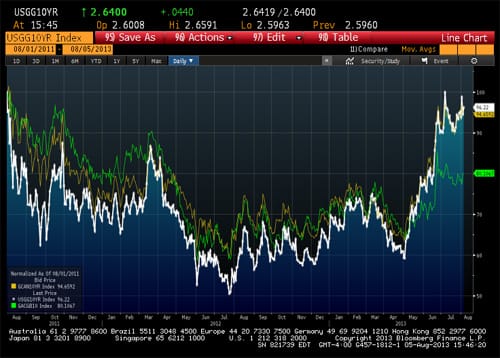CNN Debt Monger Erin Burnett Still Wrong on S&P Rating
On Tuesday night, CNN Out Front host Erin Burnett officially joined the ranks of Barack Obama's inquisitors with her special, "The Truth about Benghazi." But for two years, she's been serving as the network's fear-monger about the U.S. national debt. "It has been 730 days since the U.S. lost its top credit rating," Burnett complained Monday before asking as she does each night, "What are we doing to get it back?"
As it turns out, the U.S. has already done quite a bit. Since 2011, the federal government has slashed $2.5 trillion from the projected national debt over the next decade. Meanwhile, the nonpartisan Congressional Budget Office (CBO) reduced its annual deficit forecast to $642 billion, half of the amount it projected on the day Barack Obama first took the oath of office in January 2009. As Paul Krugman explained today, "The sharp decline in deficits means that the medium-term debt outlook is no longer remotely scary; indeed, even if you project out to 2030 it doesn't look too bad."

But always omitted from Burnett's daily debt mongering are two other inconvenient facts. As Standard & Poor's itself made clear, its August 2011 "Tea Party Downgrade" was due to Republican debt ceiling hostage-taking. Just as important, as Neil Irwin of the Washington Post reminded readers Tuesday, "over the past two years, prices in bond markets look like a wholesale rejection of the S&P thesis."
You would expect that if U.S. government debt was truly more risky than that of AAA rated nations, that the treasury would have to pay higher interest rates. But the verdict of the market these last two years cuts in the opposite direction. This chart shows the interest rate the U.S. government must pay to borrow money (the white line), along with AAA-rated Canada (the yellow line) and Australia (the green line). All three rates are indexed such that their 10-year rate as of Aug. 1, 2011, just before the debt downgrade, equals 100.
As the chart [below] shows, rates have risen and fallen in concert over the past two years. But if any definable pattern is evident, it is that the AAA nations of Canada and Australia have had to pay a premium to borrow money compared with the AA+ rated United States. It is a sign that markets have never come around to the S&P view that the United states is in fact less creditworthy than Canada and Australia.
For its part, S&P (currently under investigation by the Justice Department for improperly rating dozens of mortgage securities in the years leading up to the financial crisis) has repeatedly warned that Republican saboteurs in Congress represent the real threat to America's ability to pay off its debt. After the GOP's first debt ceiling crisis in the summer of 2011, an incredulous S&P sounded the alarm about Republicans' unprecedented obstructionism on the U.S. debt limit:
A Standard & Poor's director said for the first time Thursday that one reason the United States lost its triple-A credit rating was that several lawmakers expressed skepticism about the serious consequences of a credit default -- a position put forth by some Republicans. Without specifically mentioning Republicans, S&P senior director Joydeep Mukherji said the stability and effectiveness of American political institutions were undermined by the fact that "people in the political arena were even talking about a potential default," Mukherji said. "That a country even has such voices, albeit a minority, is something notable," he added. "This kind of rhetoric is not common amongst AAA sovereigns."
No, that rhetoric is not common amongst AAA sovereigns, but all in a day's work for today's GOP. For months, Congressional Republicans have been issuing new demands as part of their ransom for this fall's next required debt ceiling hike. That long list, one which includes everything from entitlement cuts and tax reform to new restrictions on abortion, continued to grow even after S&P raised its outlook in June for U.S. debt from "negative" to "stable." The only real risk for holders of U.S. Treasuries that S&P identified comes from Republicans on Capitol Hill:
Although we expect some political posturing to coincide with raising the government's debt ceiling, which now appears likely to occur near the Sept. 30 fiscal year-end, we assume with our outlook revision that the debate will not result in a sudden unplanned contraction in current spending--which could be disruptive--let alone debt service...
We believe that our current 'AA+' rating already factors in a lesser ability of U.S. elected officials to react swiftly and effectively to public finance pressures over the longer term in comparison with officials of some more highly rated sovereigns and we expect repeated divisive debates over raising the debt ceiling. We expect these debates, however, to conclude without provoking a sharp discontinuous cut in current expenditure or in debt service.
Apparently, Mitch McConnell and John Boehner still haven't gotten that message.
Back in June, the Post's Irwin pointed out that pointed out that America's AAA rating from Moody's and Fitch combined with continued low interest rates on U.S. Treasury bonds exposed S&P's "continuing irrelevance." He could have been writing about Erin Burnett.
After all, it's been 731 days since the U.S. lost its top credit rating. Unless she plans on explaining the twin costs of GOP economic sabotage, why is Erin Burnett still talking about it?


